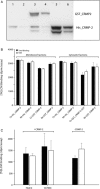Drug binding assays do not reveal specific binding of lacosamide to collapsin response mediator protein 2 (CRMP-2)
- PMID: 22672303
- PMCID: PMC6493415
- DOI: 10.1111/j.1755-5949.2012.00313.x
Drug binding assays do not reveal specific binding of lacosamide to collapsin response mediator protein 2 (CRMP-2)
Abstract
Aims: Lacosamide (LCM; SPM 927, Vimpat®) is an antiepileptic drug (AED) used as adjunctive treatment for adults with partial-onset seizures. LCM has a different mode of action from traditional sodium channel blocking AEDs in that it selectively enhances slow inactivation of sodium channels without affecting fast inactivation. Initial investigations suggested that LCM might have an additional mode of action by binding to the collapsin response mediator protein 2 (CRMP-2), which is further investigated here.
Methods: LCM binding to native and cloned human CRMP-2 was determined using radioligand binding experiments and surface plasmon resonance measurements.
Results: No specific binding of [(3) H]LCM (free concentration 100-1450 nM) to isolated or membrane bound human CRMP-2 expressed in mammalian cell systems and bacteria was observed. Surface plasmon resonance analysis also showed that LCM, over a concentration range of 0.39-100 μM, does not specifically bind to human CRMP-2.
Conclusion: The diverse drug binding methods employed here are well suited to detect specific binding of LCM to CRMP-2 in the micromolar range, yet the results obtained were all negative. Results of this study suggest that LCM does not specifically bind to CRMP-2.
© 2012 Blackwell Publishing Ltd.
Conflict of interest statement
The authors declare no conflict of interest.
Figures




References
-
- 2008 VIMPAT® (lacosamide) Prescribing Information. UCB, Inc., Smyrna , GA , US ).
-
- 2008 VIMPAT® Summary of Product Characteristics for Lacosamide. UCB Pharma, S.A., Belgium ).
-
- Errington AC, Stohr T, Heers C, Lees G. The investigational anticonvulsant lacosamide selectively enhances slow inactivation of voltage‐gated sodium channels. Mol Pharmacol 2008;73:157–169. - PubMed
-
- Sheets PL, Heers C, Stoehr T, Cummins TR. Differential block of sensory neuronal voltage‐gated sodium channels by lacosamide [(2R)‐2‐(acetylamino)‐N‐benzyl‐3‐methoxypropanamide], lidocaine, and carbamazepine. J Pharmacol Exp Ther 2008;326:89–99. - PubMed
MeSH terms
Substances
LinkOut - more resources
Full Text Sources
Miscellaneous

